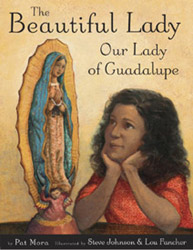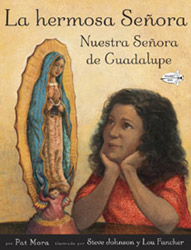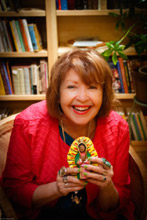|
Celebrate the Feast Day of Our Lady of Guadalupe with
The Beautiful Lady by Pat Mora

Pat Mora's works reflect the cultural heritage of Mexican-American and U.S. Latinas and Latinos through her children's books, poetry, and nonfiction. Her writing, and the art that is found in her picture books, reflects the beauty and cultural diversity of the Hispanic-American experience, and nowhere is this more evident than in her forthcoming picture book. Read the full press release.
The Beautiful Lady: Our Lady of Guadalupe
Illustrated by Steve Johnson and Lou Fancher
Knopf Books for Young Readers/ Random House
Hardcover ISBN 978-0375868382, $16.99
Library Binding ISBN 978-0375968389, $19.99
La hermosa Señora: Nuestra Señora de Guadalupe
Spanish edition
Library Binding ISBN 978-0375968402, $19.99
Dragonfly Books Paperback ISBN 978-0375868405, $8.99

Every December, Grandma Lupita tells Rose the story of Our Lady of Guadalupe. As they make paper flowers together to put around her statue, Grandma begins: Long ago, on a cold December morning near what is now Mexico City, a man named Juan Diego put on his cloak and started down the road to church.
On his way, Juan Diego sees a beautiful Lady at the top of a hill. She tells Juan Diego to go to the bishop and ask him to build a special church for her. But the bishop doesn't believe that Juan Diego has seen the Lady; he asks for a sign. Again the Lady sends Juan Diego, and again the bishop asks for a sign. Until finally, she provides one: her shining image on Juan Diego's cloak for everyone to see.
Advance Praise
"Regardless of your beliefs, the tale of Our Lady of Guadalupe is a fascinating one, and Mora gives it a warm treatment befitting the beloved material. A framing device aims the story at young readers: two little girls look at a small statue of the Virgin Mary and ask Grandma Lupita, "Who's that pretty lady?" So begins the tale: Juan Diego, the humble Aztec villager who, in December 1531, encountered a beautiful, floating woman who asked him to get the local bishop to build her a church. After the bishop demanded proof, the woman revealed to Diego a field of roses blooming despite the snow. When Diego unfolded his cloak to show the bishop the flowers, the image of Our Lady of Guadalupe was miraculously imprinted upon the cactus-fiber cloth. Mora approaches the story without tricks, using simple, delicate language, while Johnson and Fancher employ aged-looking earth-toned paintings and surround them with patterned borders when depicting the past. A two-page author's note fleshes out the tale and describes Our Lady's continuing influence."—Booklist
|
|
|
Interview with Pat Mora about The Beautiful Lady: Our Lady of Guadalupe
Media and bloggers are welcome to use this interview for publication.
1. What inspired you to write a story about Our Lady of Guadalupe?
I remember the moment at the 2008 annual conference of the American Library Association (ALA) in Anaheim when Floyd Dickman, an Ohio librarian, suggested the book idea commenting how lucky I've been to have wonderful illustrators for my books. My parents had a large image of Our Lady in their bedroom, and I've always been attracted to her presence of kindness and compassion, of caring. I didn't think I could tackle such a writing challenge. The next day, though, my dear sister Stella offered me a statue of Our Lady. Hmmm. When I returned to Santa Fe, I felt I saw images of her everywhere. Stella said, "I think you've been given an assignment."
2. What was it about the story of Our Lady of Guadalupe that you felt would appeal to children?
Fascinated by Our Lady's quiet strength, I'd written poetry for adults about her, such a strong symbol for people of Mexican descent and all who revere the feminine spirit in the universe. Since Floyd had mentioned the illustrators of my children's books, I immediately saw the project (or assignment) as a book for young readers and families. Like most authors, I always think of my children's books as suitable for all ages.
Growing up, I had a special aunt who was a wonderful storyteller, not that my siblings and I were aware of her talent as such. We just enjoyed listening. I can still hear her voice. This manuscript was an opportunity to share the power and warmth of an older family member sharing a treasured tale, of transporting young people today, in this case, two friends, to another time and another country and landscape. This beautiful legend unites a dark-skinned Señora who miraculously appears and re-appears to a dark-skinned, devout, Aztec villager.
3. What do you think the illustrations bring to your retelling of the story?
As many know, the author doesn't select the illustrator though I'm so grateful to my friends at Knopf who involved me in this incredibly challenging decision. I didn't know Steve Johnson and Lou Fancher and still haven't met them. In fact, I haven't met all of my illustrators by any means. I'm fascinated by how a duo illustrates together and don't know if they knew the story before reading the manuscript or had traveled to Mexico. I think their work is warm and beautiful. It glows. I feel the coziness of Grandma Lupita's home, I breathe deeply at the grandeur of the Mexican landscape, I see the tenderness in Grandma Lupita's and Juan Diego's affection when they touch Our Lady's image, I savor Rose's and Terry's quiet friendship on a cold December afternoon.
4. December 12 is Our Lady's Feast Day and is widely celebrated. Please elaborate on the importance of this religious and cultural tradition for Mexicans and Mexican-Americans.
Feast days are like birthdays or anniversaries. They are occasions to remember an event in the past and sometimes to honor someone. Just the other night, I saw a program that showed images of processions and celebrations on Dec. 12 as the beginning of the holiday season in the Southwest that for Catholics ends on Jan. 6th, the Feast of the Three Kings or Epiphany. Along with the Mexican flag, Our Lady is a symbol of Mexican independence and pride, and a symbol for social justice groups throughout the Americas. As I state in the author note, people from diverse backgrounds are drawn to this image and story that are so central to the history and culture of Mexico and Mexican-Americans.
Our Lady's image is in car repair shops, bakeries and restaurants. She has been the subject of fine art, popular art, and in pop-culture: on mouse pads, tattoos, T-shirts. She's with the people. Our Lady of Guadalupe is a comforting protectoress who doesn't discriminate.
|


